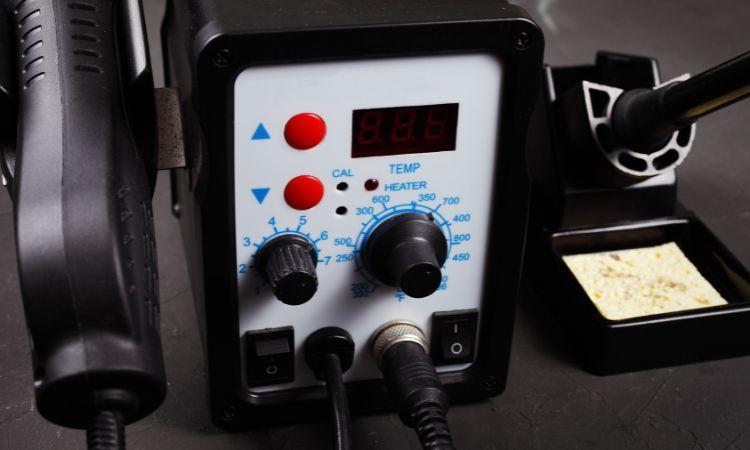The global soldering stations and accessories market size reached approximately USD 1.13 billion in 2023. The market is further projected to grow at a CAGR of 6.7% between 2024 and 2032, reaching a value of USD 2.04 billion by 2032. As soldering continues to be an essential process in various industries, choosing the right soldering station becomes paramount. Whether you’re an electronics enthusiast, a professional in the field, or a hobbyist, the quality and efficiency of your soldering projects depend significantly on the soldering station you use.
In this comprehensive guide, we’ll explore the different types of soldering stations, the key features to consider, factors related to quality and durability, budget considerations, and tips for making the final decision. By the end of this article, you’ll have the knowledge and confidence to select the perfect soldering station for your specific needs.
Types of Soldering Stations
Soldering stations come in various types, each with its own set of features and advantages. Understanding these types is the first step in choosing the right soldering station.
Analog Soldering Stations
Analog soldering stations are the most basic and traditional type. They typically feature a dial or knob for adjusting the temperature. These stations are straightforward and reliable but may lack some of the advanced features of digital stations.
Pros:
- Simplicity and ease of use.
- Generally cost-effective.
- Durable and long-lasting.
Cons:
- Limited temperature control precision.
- Lacks digital display for temperature readout.
- Not suitable for extremely precise work.
Digital Soldering Stations
Digital soldering stations offer more precise temperature control, often with a digital display for accurate temperature readout. These stations are suitable for a wide range of soldering tasks and provide greater control over the soldering process.
Pros:
- Precise temperature control.
- Digital temperature display.
- Suitable for delicate and precise soldering tasks.
Cons:
- Typically more expensive than analog stations.
- May require more maintenance due to electronic components.
Temperature-Controlled Soldering Stations
Temperature-controlled soldering stations, whether analog or digital, allow you to set and maintain a specific temperature throughout your soldering work. This feature is essential for consistent and high-quality soldering joints, as different solder alloys and components require specific temperature settings.
Pros:
- Precise temperature regulation.
- Consistent soldering results.
- Suitable for a wide range of soldering tasks.
Cons:
- May be more expensive.
- Initial setup and calibration may be required.
Multi-Function Soldering Stations
Some soldering stations come with additional features, such as built-in soldering iron holders, fume extractors, and solder wire feeders. These multi-function stations can be convenient for those who need a complete soldering solution in one package.
Pros:
- All-in-one solution for soldering needs.
- Streamlines the soldering process.
- Saves space on the workbench.
Cons:
- Generally more expensive than basic stations.
- Additional features may not be necessary for all users.
Now that you have an understanding of the different types of soldering stations available, it’s time to delve deeper into the key features that should guide your decision-making process.
Key Features to Consider
When choosing a soldering station, several key features should be at the forefront of your decision-making process. These features directly impact the performance and usability of the station. Let’s explore each of them in detail:
Temperature Control Capabilities
One of the most critical features of a soldering station is its temperature control capabilities. The ability to adjust and maintain the right soldering temperature is essential for achieving clean and reliable solder joints.
The Importance of Adjustable Temperature
Soldering involves melting a solder alloy to create a bond between components. Different solder alloys have specific melting points, so being able to adjust the temperature to match the solder you’re using is crucial. Adjustable temperature control ensures that you don’t overheat or underheat the solder, which can lead to poor-quality joints or component damage.
Temperature Range Considerations
Consider the temperature range offered by the soldering station. A broad temperature range allows you to work on a variety of projects, from delicate electronics to larger components. Look for stations with a wide range, typically from around 200°C to 480°C (392°F to 896°F), to cover most soldering applications.
Power and Wattage
The power and wattage of a soldering station play a significant role in its performance. Wattage determines how quickly the soldering iron can heat up and recover temperature during soldering.
Matching Power to Your Soldering Requirements
For smaller, intricate soldering tasks, a lower wattage soldering station may suffice. However, larger projects or soldering tasks that involve heavy components or thicker wires may require a higher wattage station. Match the power of the station to your specific soldering requirements to ensure efficient and reliable performance.
Soldering Iron Compatibility
Not all soldering irons and tips are compatible with every soldering station. It’s essential to choose a station that supports a range of soldering iron types and tip sizes. This compatibility ensures that you have the flexibility to switch between different tips for various soldering tasks.
Interchangeable Tips and Compatibility with Various Brands
Look for soldering stations that offer interchangeable tips, as this allows you to customize your soldering iron for different projects. Additionally, some stations are compatible with popular soldering iron brands, such as Hakko or Weller, which can make it easier to find replacement parts and tips.
ESD Protection
ESD (Electrostatic Discharge) protection is vital when working with sensitive electronic components. ESD can damage or destroy delicate chips and circuits, so a soldering station with built-in ESD protection is crucial for electronics work.
Protecting Sensitive Electronic Components
ESD protection in a soldering station ensures that any static discharge is safely grounded, preventing it from reaching your components. Look for stations with ESD-safe features, including grounding straps, anti-static mats, and ESD-safe soldering irons.
Display and User Interface
The display and user interface of a soldering station affect how easy it is to use and control. Digital stations typically have a digital display that shows the current temperature, making it easy to set and monitor. Analog stations, on the other hand, use dials or knobs for temperature adjustment.
Digital vs. Analog Displays
Digital displays provide precise temperature readouts and easy adjustment, which is especially useful for tasks that require precise temperature control. Analog stations, while simple, may require a bit more guesswork when setting the temperature.
Ease of Use and Visibility
Consider the visibility of the temperature display and the ergonomics of the user interface. Stations with clear and well-lit displays are easier to work with, especially in dimly lit environments. The user interface should be intuitive and comfortable to use for extended periods.
Now that you have a solid understanding of the key features to consider when choosing a soldering station, let’s discuss the importance of quality and durability in your selection.
Quality and Durability
Investing in a high-quality soldering station is essential, as it ensures reliability, longevity, and consistent performance. Here are factors related to quality and durability that you should consider:
Materials and Build Quality
Inspect the materials used in the construction of the soldering station. High-quality stations typically feature robust metal casings that are durable and heat-resistant. Stations with cheap plastic components may not withstand the rigors of heavy use and high temperatures.
Brands with a Reputation for Reliability
Research reputable brands with a track record of producing reliable soldering stations. Brands like Weller, Hakko, and Metcal are known for their quality and durability. While you may pay a premium for these brands, the investment is often worth it in terms of performance and longevity.
Warranty and Customer Support
Check the warranty and customer support offered by the manufacturer. A solid warranty provides peace of mind, as it means the manufacturer stands behind the quality of their product. Additionally, good customer support can be invaluable if you encounter any issues or have questions about your soldering station.
In the next section, we’ll delve into budget considerations and how to strike a balance between features and cost when choosing a soldering station.
Budget Considerations
Setting a budget for your soldering station is a practical step in the decision-making process. While it’s tempting to go for the most feature-rich station, it’s essential to find a balance between your budget and your soldering needs.
Setting a Budget for Your Soldering Station
Start by determining how much you’re willing to spend on a soldering station. Your budget should consider not only the initial purchase cost but also any additional accessories or replacement parts you may need. Remember that a higher-quality station often comes with a higher price tag, but it can pay off in terms of performance and durability.
Balancing Features and Cost
Consider the features that are essential for your soldering projects. If you primarily work on small electronics and precision tasks, you may not need a high-wattage, multi-function station. Conversely, if you frequently tackle a variety of soldering jobs, investing in a versatile station with temperature control and ESD protection may be a wise choice.
It’s also worth noting that some budget-friendly soldering stations can offer excellent value for the price. Do your research and read user reviews to find hidden gems that offer a good balance between cost and performance.
Tips for Making the Final Decision
Choosing the right soldering station can be a significant decision, so here are some tips to help you make the final choice:
Reading Product Reviews and User Experiences
User reviews and experiences can provide valuable insights into the performance and reliability of a soldering station. Look for reviews from individuals who use the station for tasks similar to yours. Pay attention to both positive and negative feedback to get a well-rounded view.
Read More Articles
Seeking Recommendations from Experienced Soldering Professionals
If you have connections in the soldering or electronics industry, don’t hesitate to seek recommendations from experienced professionals. They can offer valuable advice based on their years of hands-on experience and may point you toward brands or models they trust.
Testing the Station if Possible Before Purchase
If you have the opportunity, visit a local electronics store or workshop that allows you to test different soldering stations. Hands-on experience can help you assess factors such as ergonomics, ease of use, and temperature control. Testing the station before purchase can also give you a better sense of its build quality.
Conclusion
In conclusion, choosing the right soldering station is a critical step in ensuring the success of your soldering projects. The global soldering stations and accessories market is on a growth trajectory, underlining the importance of making an informed decision. By considering the type of soldering station that suits your needs, evaluating key features like temperature control and ESD protection, prioritizing quality and durability, managing your budget, and seeking recommendations, you can confidently select a soldering station that will serve you well for years to come.
Remember that your soldering station is a valuable tool that can greatly impact the quality and efficiency of your work. Take the time to research and choose wisely, and you’ll be rewarded with cleaner, more reliable solder joints and a smoother soldering experience.



